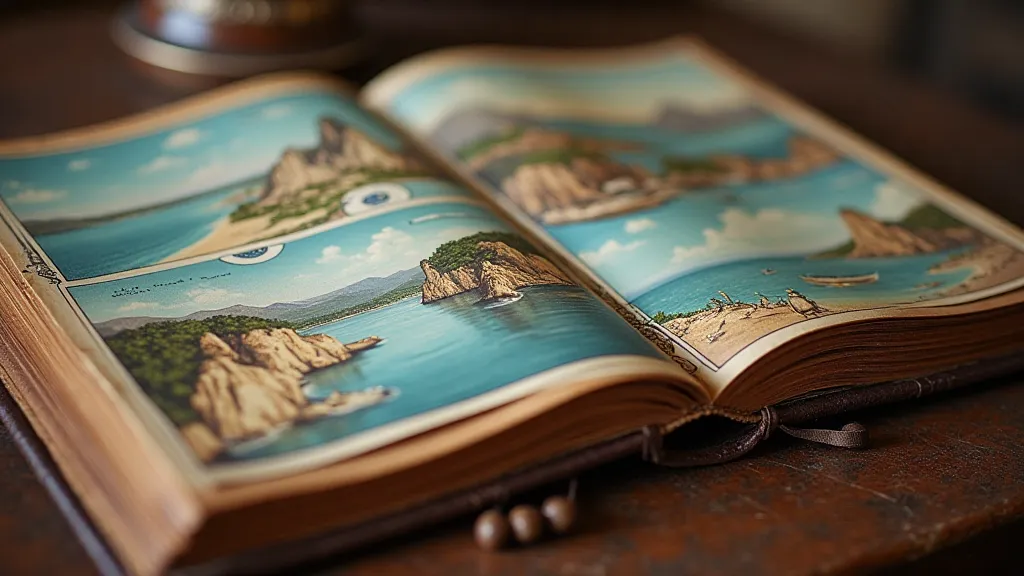The Postcard's Shadow: Examining the Darker Side of Tourism Imagery
The feel of aged paper between your fingers, the faint scent of ink and time… collecting vintage postcards is, for many of us, a deeply sensory experience. There’s a tangible connection to the past, a window into lives and landscapes long gone. We pore over images of bustling seaside resorts, snow-capped mountains, and grand cityscapes, imagining the sender and recipient, the story whispered across miles. But what if those idyllic scenes, so carefully preserved on these little rectangles, weren't the whole story? What if the charming depictions of foreign lands hid a more complicated, even unsettling, truth?
My own postcard collecting began innocently enough. I was drawn to the vibrant colours, the optimistic lettering, the promise of adventure. I’m particularly drawn to early 20th century travel postcards, a golden age of European tourism that seemed to radiate confidence and progress. I recall finding a stunning card of a Moroccan marketplace, the vibrant hues of spices and textiles seemingly jumping off the paper. It felt… magical. But as I delved deeper, as I began to study the historical context, a shadow began to fall across that initial enchantment.

The Colonial Gaze
The early 20th century was a period of intense colonial expansion. European powers carved up the world, and the burgeoning tourism industry became intrinsically linked to this power dynamic. Postcards, as mass-produced, easily-transported souvenirs, played a crucial role in shaping perceptions of colonized lands. Often, they presented a highly romanticized, and ultimately inaccurate, view of these places.
The problem wasn’t necessarily that the scenes themselves were fabricated, although outright falsification sometimes occurred. The more insidious issue lay in the perspective. Postcards frequently depicted colonized people as “exotic” or “primitive,” reinforcing stereotypes and hierarchies. They were often presented as spectacles, frozen in time, rather than as dynamic, complex societies with their own rich histories and cultures. The “charm” we see today can be directly linked to the fact that these images served a purpose – to justify colonial rule, to entice tourists to spend money, and to perpetuate a skewed understanding of the world.
Think about the language used on the backs of these cards. Phrases like "Picturesque Natives," "The Mystery of the Orient," or descriptions of cultures as "unspoiled by Western influence" are jarring when viewed through a modern lens. These weren’t neutral observations; they were carefully constructed narratives designed to reinforce a sense of European superiority.
The Craftsmanship & the Context
It's crucial to acknowledge the artistry involved in creating these postcards. The lithography was often exceptional. Early colour printing was a marvel of engineering and skill, and the artists who created these scenes were talented illustrators. I find myself constantly admiring the detail in the clothing, the precision of the architectural renderings, the mastery of light and shadow. The postcards themselves are miniature works of art, representing a specific era of printing techniques and artistic conventions.
Consider the process: an artist would create an image, often based on photographs or second-hand accounts, which would then be transferred to a lithographic stone. Multiple stones would be used for each colour, requiring an immense amount of precision and coordination. The result was a mass-produced image, but one that still carried the imprint of human skill. The beauty of these cards becomes even more poignant when we understand the labour that went into their creation, and the context in which they were produced.
Beyond the Surface: A Collector's Responsibility
For the serious postcard collector, appreciating these vintage treasures requires more than just aesthetic admiration. It demands a critical and nuanced understanding of the historical context. We have a responsibility to acknowledge the problematic aspects of these images, to understand the power dynamics they represent, and to avoid perpetuating harmful stereotypes.
This doesn’t mean we should abandon collecting vintage postcards. Quite the opposite. It means we should approach the hobby with greater awareness and sensitivity. We can use our collections to educate others about the complexities of the past, to spark conversations about colonialism, and to challenge simplistic narratives.

Restoration and Preservation: A Delicate Balance
The preservation of these historical artifacts is also a delicate matter. While cleaning and restoring a postcard can enhance its visual appeal, we must be mindful of preserving its integrity. Overly aggressive restoration techniques can erase valuable clues about its history – the types of inks used, the stamps it has carried, the handwriting on the back. The wear and tear, the faded colours, the slight imperfections, all contribute to the postcard’s story.
There are simple steps we can take to protect our collections. Storing postcards in acid-free sleeves and albums is crucial. Keeping them away from direct sunlight and extreme temperatures will prevent further degradation. And resisting the urge to “perfect” them is perhaps the most important step of all. The patina of age is part of their charm.
A Legacy of Images
Collecting vintage postcards offers a fascinating glimpse into the past, a tangible link to lives lived and experiences shared. However, it's crucial to move beyond the superficial beauty of these images and grapple with the complex historical context in which they were created. By acknowledging the shadows that lurk behind the idyllic scenes, we can gain a deeper appreciation for these artifacts and use them to promote a more nuanced and informed understanding of our world. The postcards themselves are beautiful, but the story they tell is far more complex and deserving of our careful consideration.






